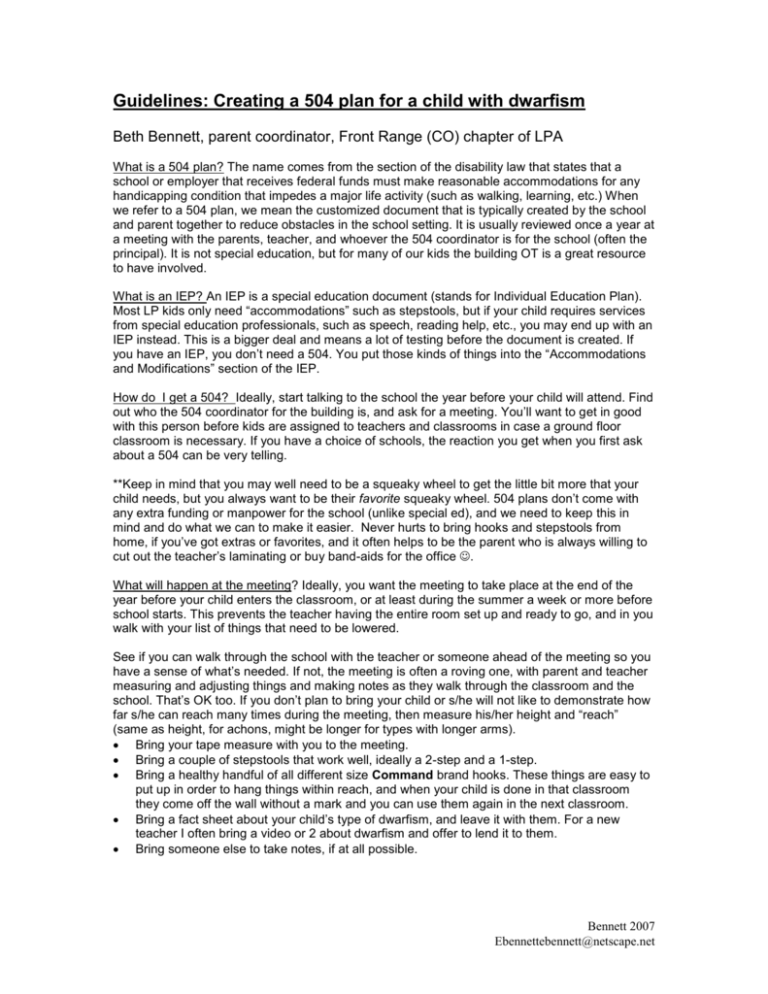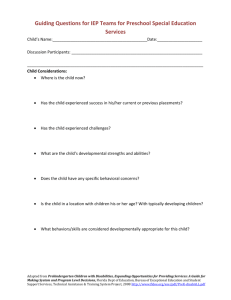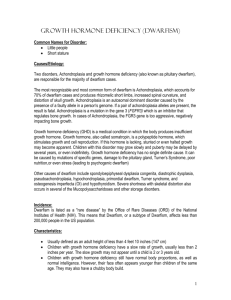Guidelines: Creating a 504 plan for a child with dwarfism
advertisement

Guidelines: Creating a 504 plan for a child with dwarfism Beth Bennett, parent coordinator, Front Range (CO) chapter of LPA What is a 504 plan? The name comes from the section of the disability law that states that a school or employer that receives federal funds must make reasonable accommodations for any handicapping condition that impedes a major life activity (such as walking, learning, etc.) When we refer to a 504 plan, we mean the customized document that is typically created by the school and parent together to reduce obstacles in the school setting. It is usually reviewed once a year at a meeting with the parents, teacher, and whoever the 504 coordinator is for the school (often the principal). It is not special education, but for many of our kids the building OT is a great resource to have involved. What is an IEP? An IEP is a special education document (stands for Individual Education Plan). Most LP kids only need “accommodations” such as stepstools, but if your child requires services from special education professionals, such as speech, reading help, etc., you may end up with an IEP instead. This is a bigger deal and means a lot of testing before the document is created. If you have an IEP, you don’t need a 504. You put those kinds of things into the “Accommodations and Modifications” section of the IEP. How do I get a 504? Ideally, start talking to the school the year before your child will attend. Find out who the 504 coordinator for the building is, and ask for a meeting. You’ll want to get in good with this person before kids are assigned to teachers and classrooms in case a ground floor classroom is necessary. If you have a choice of schools, the reaction you get when you first ask about a 504 can be very telling. **Keep in mind that you may well need to be a squeaky wheel to get the little bit more that your child needs, but you always want to be their favorite squeaky wheel. 504 plans don’t come with any extra funding or manpower for the school (unlike special ed), and we need to keep this in mind and do what we can to make it easier. Never hurts to bring hooks and stepstools from home, if you’ve got extras or favorites, and it often helps to be the parent who is always willing to cut out the teacher’s laminating or buy band-aids for the office . What will happen at the meeting? Ideally, you want the meeting to take place at the end of the year before your child enters the classroom, or at least during the summer a week or more before school starts. This prevents the teacher having the entire room set up and ready to go, and in you walk with your list of things that need to be lowered. See if you can walk through the school with the teacher or someone ahead of the meeting so you have a sense of what’s needed. If not, the meeting is often a roving one, with parent and teacher measuring and adjusting things and making notes as they walk through the classroom and the school. That’s OK too. If you don’t plan to bring your child or s/he will not like to demonstrate how far s/he can reach many times during the meeting, then measure his/her height and “reach” (same as height, for achons, might be longer for types with longer arms). Bring your tape measure with you to the meeting. Bring a couple of stepstools that work well, ideally a 2-step and a 1-step. Bring a healthy handful of all different size Command brand hooks. These things are easy to put up in order to hang things within reach, and when your child is done in that classroom they come off the wall without a mark and you can use them again in the next classroom. Bring a fact sheet about your child’s type of dwarfism, and leave it with them. For a new teacher I often bring a video or 2 about dwarfism and offer to lend it to them. Bring someone else to take notes, if at all possible. Bennett 2007 Ebennettebennett@netscape.net 504s for Little People: preschool Areas of consideration: Preschool Please consider these to be suggestions for solving the problems that short stature creates for a child’s independent access to school activities. Every school is different, and is unlikely to need all of these modifications. Feel free to involve parents and child in creating other, better solutions when needed. LP refers to Little Person, and is the most accepted way to refer to a person with dwarfism. General Building Access: doorbell or handicap access button (check height) to open heavy exterior door building errands with a buddy for heavy interior doors hold adult hand or railing on stairs to decrease fall risk start child at front of lines, allow peers to go around no pulling by arms for elbow dislocation risk no lifting by peers (LP can say “kids don’t pick up kids!”) skid-resistant stepstools at all relevant drinking fountains modifications in 1 stall of each hallway bathroom. Use velcro inside stall to close door provide fact sheet to all teachers (specials, aides) school library to stock dwarfism-related books e.g., Never Sell Yourself Short PE teacher encouraged to consult parent/child as needed, consider assigning LP child to spend same amount of time as peers rather than distance. Consider special job for LP if PE unit or event (e.g., field day) is excessively difficult or distressing. Bathroom preschool height toilet stepstool for toilet (skid resistant surface- wide platform preferred) stepstool for sink (skid resistant surface) tape marks on floor to guide custodians and others as to placement of stepstools lower soap dispenser lower paper towel provide or store wet wipes provide help if needed for personal hygiene. Private signal to teacher. lower trash can switch extender for lights or lights left on or auto-on lights cord extension from lever handle on both sides of door for access Outside increase supervision for climbing due to neck instability provide alternative activities such as bubbles, chalk, chinese jumpropes lengthen chains on at least one swing stepstool or milk crate for access to high toys encourage water bottle, hat, rest in shade for decreased heat tolerance Classroom: supplies within reach several stepstools for use by all children heavy/bulky items modified or lowered cords on lever door handles for access extenders or auto-on lightswitches or left on appropriately sized chair e.g., tripp trapp if needed for extended sitting. PT or OT to help with fitting and adjustments. Bennett 2007 Ebennettebennett@netscape.net low stepstools or blocks placed under feet e.g., at centers (no dangling) backjack or similar floor chair if needed for back pain use wagon for walking field trips, allow others to ride with LP assign adult to LP child for all fire and other drills. Include in sub plan. discuss with parent permission to carry child in true evacuation low table for floor-based work activities Miscellaneous: all building staff educated about dwarfism, able to answer questions from students (direct to LP or parent if needed). encourage questions, discourage staring and whispering consider accessing one of many documentaries on dwarfism to view or circulate among staffask parents if they own copies. consider visit from an adult LP to address curiosity, questions, teasing if needed. frequent communication with parents as questions/concerns arise. Other: Bennett 2007 Ebennettebennett@netscape.net 504s for Little People: elementary grades Areas of Consideration General Building Access: doorbell or handicap access button (check height) to open heavy exterior door building errands with a buddy for heavy interior doors hold adult hand on stairs to decrease fall risk start child at front of lines, allow peers to go around no pulling by arms for elbow dislocation risk no lifting by peers skid-resistant stepstools at all relevant drinking fountains tape marks to indicate placement of stepstools modifications in 1 stall of each hallway bathroom. Use velcro inside stall to close door provide fact sheet to all teachers (specials, aides) school library to stock dwarfism-related books e.g., Never Sell Yourself Short PE teacher encouraged to consult parent/child as needed, consider assigning LP child to spend same amount of time as peers rather than distance. Consider special job for LP if PE unit or event (e.g., field day) is excessively difficult or distressing. Bathroom preschool height toilet stepstool for toilet (skid resistant surface- wide platform preferred) stepstool for sink (skid resistant surface) tape marks to indicate placement of stepstools lower soap dispenser lower paper towel provide or store wet wipes provide help if needed for personal hygiene. Private signal to teacher. lower trash can switch extender for lights or lights left on or auto-on lights cord extension from lever handle on both sides of door for access Outside increase supervision for climbing due to neck instability provide alternative activities such as bubbles, chalk, chinese jumpropes lengthen chains on at least one swing stepstool or milk crate for access to high toys encourage water bottle, hat, rest in shade for decreased heat tolerance Classroom: supplies within reach several stepstools for use by all children heavy/bulky items modified or lowered cords on lever door handles for access extenders or auto-on lightswitches or left on appropriately sized chair e.g., tripp trapp if needed for extended sitting. PT or OT to help with fitting and adjustments. appropriate chair at computer station if much time is spent there low stepstools or blocks placed under feet e.g., at centers (no dangling) backjack or similar floor chair if needed for back pain Bennett 2007 Ebennettebennett@netscape.net use wagon for walking field trips, allow others to ride with LP assign adult to LP child for all fire and other drills. Include in sub plan. discuss with parent permission to carry or piggyback child in true evacuation discuss with peers that “size doesn’t mean age” and to treat LP according to age monitor writing for fatigue – soft splint may help late in day or with homework for wrist instability extra set of books at home if homework requires them permit wheeled backpack to reduce joint damage Miscellaneous: all building staff educated about dwarfism, able to answer questions from students (direct to LP or parent if needed). encourage questions, discourage staring and whispering (talk to the LP, not about the LP) consider accessing one of many documentaries on dwarfism to view or circulate among staffask parents if they own copies. consider visit from an adult LP to address curiosity, questions, teasing if needed. frequent communication with parents as questions/concerns arise. Other: consider modifications needed for frequent ear infections (e.g., seating, cueing) consider modifications needed for attention or organization (e.g., pre-planning, chunking of work, visible timer) Bennett 2007 Ebennettebennett@netscape.net






